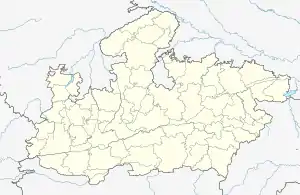Agar, Madhya Pradesh
Agar is a town with a municipal government in the state of Madhya Pradesh, India. It is the administrative headquarters for the Agar Malwa District which was formed in 2013 from a part of Shajapur District. The town is situated along the ujjain—Kota SH-27 highway.
Agar | |
|---|---|
City | |
 Agar Location in Madhya Pradesh, India  Agar Agar (India) | |
| Coordinates: 23°42′59″N 76°00′59″E | |
| Country | India |
| State | Madhya Pradesh |
| District | Agar Malwa |
| Elevation | 505 m (1,657 ft) |
| Population (2011) | |
| • Total | 37,950 |
| Languages | |
| • Official | Hindi, Malwi |
| Time zone | UTC+5:30 (IST) |
| PIN | 465441 |
| ISO 3166 code | IN-MP |
| Vehicle registration | MP-70 |
| Nearest city | Ujjain, Indore, Jhalawar, Dewas. |
| Literacy | 65%% |
| Lok Sabha constituency | Dewas-Shajapur |
| Website | www |
History
As per earlier history, one Agria Bhil founded Agar in the 10th century. But immediately after seizing it, Jahala Rajputs ruled it upto the 18th century. Then it was passed on to the Panwars of Dhar and then to the Scindia. Agar was the capital of the Parmar Kingdom during the 10th century along with Avantika (Ujjain), then it was the most popular visiting place of Mughal kingdom when Mandu was its capital. The Mughals liked to spend summer vacations there because the temperature during summer nights was very low compared to other areas in the region. During the Sindhia state a number of palaces were built which today are used for city court and for other government offices.
Demographics
As of 2001 India census,[1] In the 2001 census, Agar had a population of 31,202, where males constituted 51.8% of the population and females 48.2%. In the 2011 census the population had grown to 50,000. Males now constituted 52% of the population and females 48%.
Tourism
Agar is a tourist attraction, famous for the temple of Jai Baba Baijnath, which was built by the wife of a British Lt. Colonel after a battle in Afghanistan in 1879 where his life was miraculously saved, allegedly, by Lord Shiva's intervention.[2]
The city has two lakes, Moti Sagar (bada talab) and Ratna Sagar (ratodia talab), which account for the large amount of water in the city. There is also a dam on the Kali Sindh River, the Parsukheri dam; two other dams are Pipliya Kumar dam and Tillar dam.
Some notable areas are the Gufa Barda (Tulja Bhawani mandir), Kewada Swami (Kal Bhairav mandir), Kamal Kundi, Ganesh Temple (Nr.Bada Talab) and Bade Ganeshji, Tulja Bhawani mandir, ranchod mandir, and Gopal mandir.
A temple of Lord Krishna (also known as Haveli), which has been served by a Hindu Kayastha family for around four hundred years, is also very famous among the locals.
Agar is famous for its red soil. This red soil is found only in Agar and limited to about 1–2 km outside of it.
Banyan trees, some of them many, many years old, are found in Agar Malwa.
Agar Malwa is also famous for Sri Rani Sati Dadi Ji's Temple and Chintaharan Ganesh Mandir Temple at Bada Talab. Worshippers throng to the Chintaharan Ganesh Mandir Temple because the deity here is traditionally known as Chintaharan Ganesh, meaning "the assurer of freedom from worldly anxieties". A very old Radha Krishna mandir of phool Mali pura was now renovated there is a magnificent black statue of Krishna with Radha and the famous temple of Hanuman gadhi it is also an oldest akhada of agar।
Transport
Agar is will connected by private bus services to all major cities of Madhya Pradesh and nearby region.
References
- "Census of India 2001: Data from the 2001 Census, including cities, villages and towns (Provisional)". Census Commission of India. Archived from the original on 16 June 2004.
- "Archived copy". Archived from the original on 6 May 2016. Retrieved 29 June 2016.CS1 maint: archived copy as title (link)